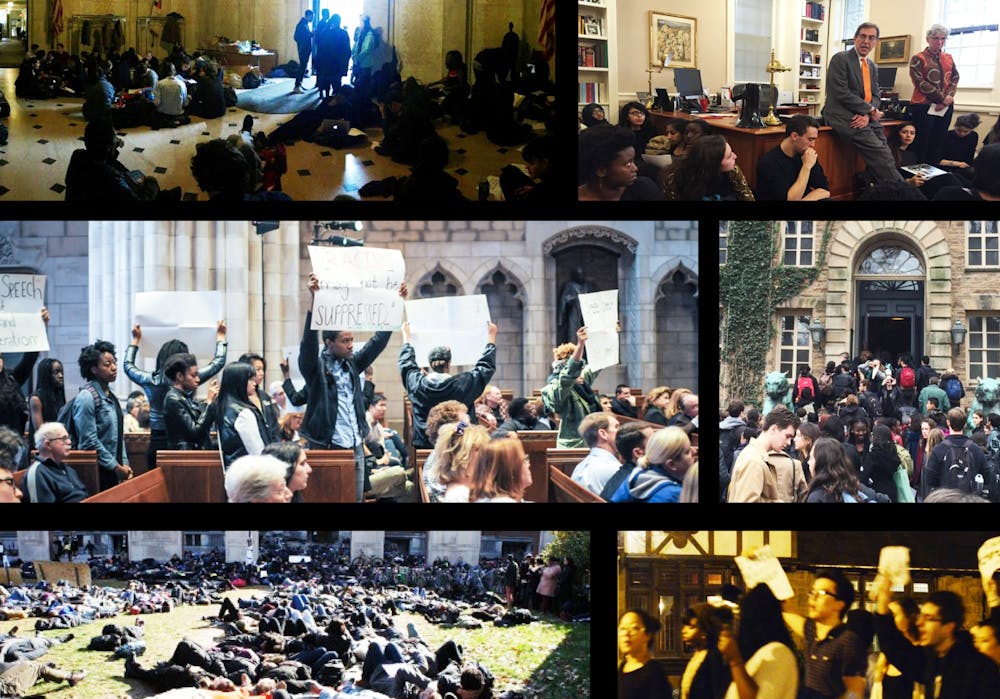At 11:30 a.m. on Nov. 18, 2015, over 200 Princeton students walked out of their lectures and marched toward Nassau Hall. At their helm was the Black Justice League (BJL), a student group dedicated to fighting anti-Black racism.
On the steps of the 261-year-old edifice — once at the heart of the American political story, erected with funds from the slave trade — the protestors called on the University to dismantle its institutional racism.
Their demands included the creation of affinity housing and spaces for Black students, cultural competency training for faculty, an undergraduate distribution requirement dedicated to the history of marginalized peoples, and the removal of Woodrow Wilson Class of 1879’s name from the policy school and residential college.
With their list in hand, the students entered the Nassau Hall office of President Christopher Eisgruber ’83. Organizers passed around a sign-up sheet for students to sit in Eisgruber’s office during his work hours for the rest of the week — or until he committed to pursue their demands.
Walking into Nassau Hall that early afternoon, the students had every expectation of returning to their dorms that evening. But five, 10, 20 hours later, they were still in Eisgruber’s office. By the end of the 33rd hour, they finally left — the president’s signature on a revised set of demands in hand.
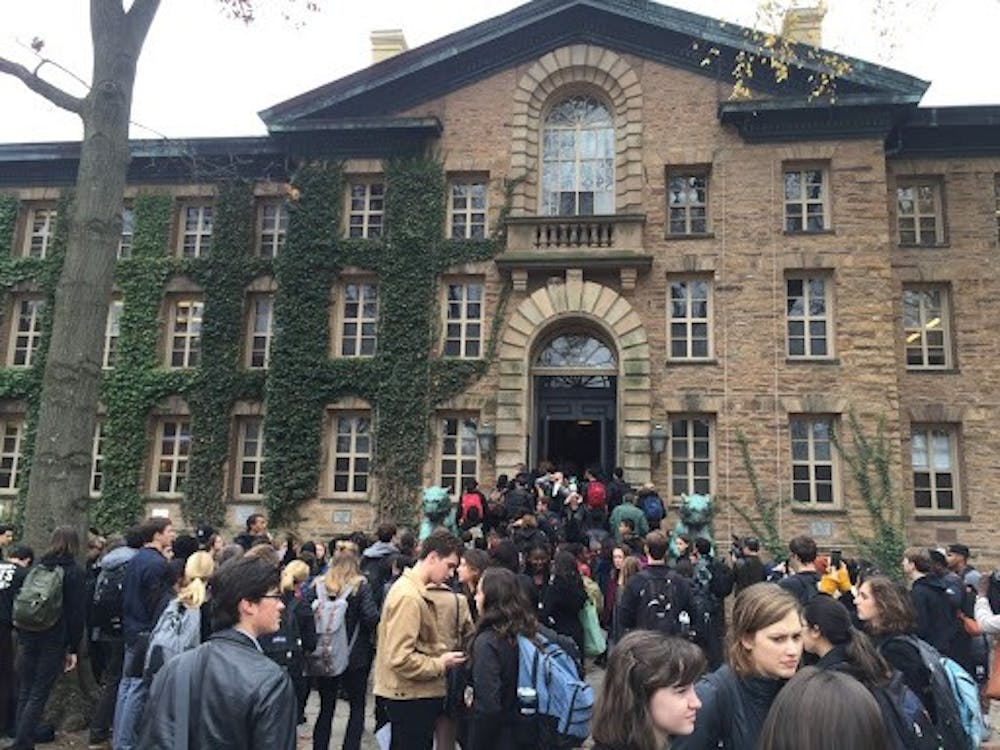
Student protestors enter Nassau Hall in Nov. 2015.
Courtesy of University Press Club
Every member of the BJL has since graduated, and the organization no longer exists. But in the past month, the group has reemerged at the forefront of campus discourse, after the University met its demand for the removal of Wilson’s name on June 27.
As campus collective memory fades, the BJL’s legacy has become shrouded in more questions than answers.
On July 4, over 350 faculty members signed an open letter that, among 48 anti-racist demands, called upon the University to “assign proper credit to the Black Justice League for the removal of Woodrow Wilson’s name” and to issue “a formal public University apology to [its] members.”
In an op-ed published four days later, Professor Joshua Katz condemned the BJL as a “local terrorist organization” and deemed a recent Instagram Live hosted by a BJL alum “one of the most evil things” he had ever seen.
Eisgruber told the ‘Prince’ he “personally and strongly” objected to Katz’s characterization, adding in a recent column, “The Black Justice League was a group of non-violent student activists who protested about Woodrow Wilson’s racism and other issues.”
“Their arguments and rhetoric, even if others found them provocative or offensive, were protected by Princeton’s commitment to the freedom of speech,” he added.

Current anti-racist activists from Change WWS Now, a coalition of students from the School of Public and International Affairs (SPIA) — formerly the Woodrow Wilson School — drew inspiration from the BJL’s sit-in demands when drafting their open letter, which precipitated the renaming decision.
“A part of our activism,” said Janette Lu ’20, one of the letter’s four authors, “is resurfacing history.”
For many, “resurfacing history” has meant recalling the BJL’s occupation of Nassau Hall. But the BJL alumni interviewed for this piece stressed that the sit-in was only a small fraction of their work.
By the time BJL members occupied Nassau Hall, they had been organizing protests, campaigning, and meeting with administrators for over a year.
‘How did we get here?’: The BJL’s early days
The BJL was founded in the fall of 2014, as uprisings for racial justice swept the nation. In August, police officer Darren Wilson had killed Michael Brown in Ferguson, Mo. At Princeton, 17 Black students, who, in their words, had been “radicalized” by Brown’s death, came together to form the group.
Their first protest was impromptu, haphazardly organized over Facebook and listservs on the night of Nov. 24, 2014, hours after a grand jury acquitted Officer Wilson. At 11 p.m., three students gathered in the Women*s Center to make posters. The three soon turned to 25, and then to hundreds. A growing crowd of students marched from Frist Campus Center’s South Lawn down Prospect Avenue.
Destiny Crockett ’17 — one of the original three protestors — said that many students on their way to revel at eating clubs joined the protest instead.
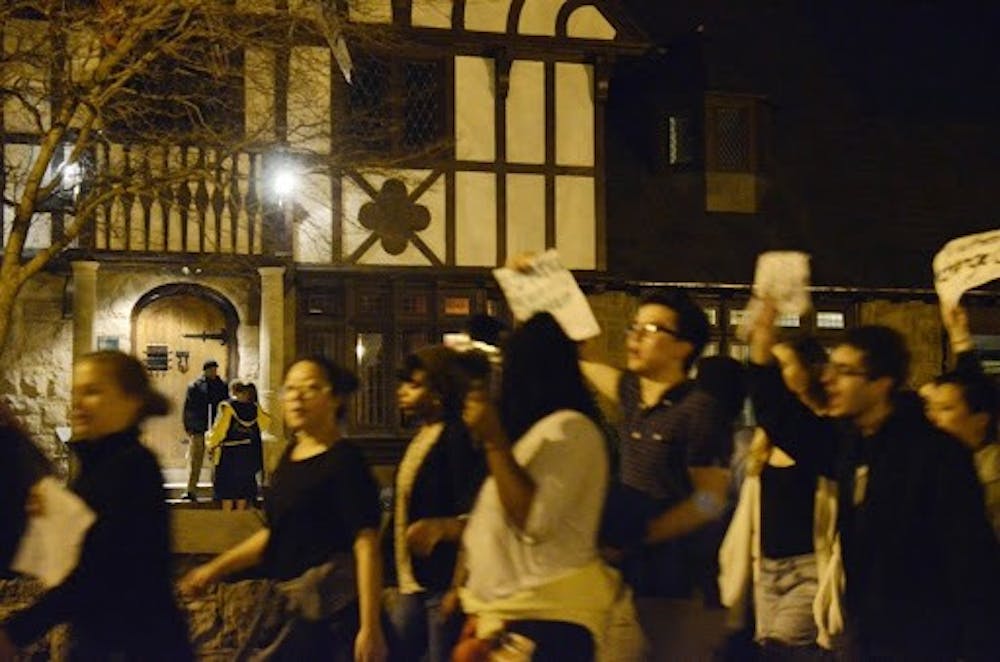
On Nov. 24, 2014, students marched down Prospect Ave.
From The Daily Princetonian
Eight days later, SPIA Dean Cecilia Rouse and Eisgruber participated in a panel, titled “What Kind of Diversity: Is Princeton Too Narrowly Focused on Race and Ethnicity Rather Than Economic Diversity?” Philosophy professor Peter Singer moderated the panel, which included Russell Nieli GS ’79 of the James Madison Program and sociologist Alexandria Walton Radford GS ’09.
In a June 2020 Medium article BJL alumni criticized the event, writing that even as cries of Black Lives Matter rang out nationwide, the University “determined it was appropriate to debate the very presence of Black students on campus while simultaneously preventing those same students from sitting on the panel.”
At the event, the BJL held a silent protest. Each protestor carried two sheets of colored paper. They held up red when they objected to what was said, and green when they agreed.
“The racial diversity we have in this country is bad diversity and let me explain why,” Nieli said, according to the ‘Prince’ in 2014. Students raised their red sheets.
Right after the panel, the BJL directly confronted Eisgruber for the first time. In their June open letter, alumni alleged that the president had “urged [protesters] to ‘prove’ to [him] the ways in which Princeton continues to facilitate a hostile experience for Black students.”
After the exchange, BJL members were invited to a series of meetings and discussions with University administrators.
“At that point, they were very much trying to placate,” said Joanna Anyanwu ’15 GS, a former BJL member.
“We got the run-around,” Crockett added. “We would meet with one person, and then they would say, ‘Oh, you should meet with this other person.’”
Participating in these meetings didn’t stop the BJL from continuing their activism in public. On Dec. 4, 2014, around 500 students walked out of their classes to protest the acquittal of Daniel Pantaleo, the New York police officer who killed Eric Garner. Silently, students marched towards the Frist North Lawn with their hands in the air. Once assembled, they chanted, “Hands Up, Don’t Shoot,” “No Justice, No Peace,” “Black Lives Matter.” Activists, including Anyanwu, addressed the protesters.
“How did we get here? How do we convince people that our lives matter?” she said, in tears. “I don’t want to raise kids in this world.”
“I can’t breathe,” she closed. “We can’t breathe.”
Beginning at 12:01 p.m. — the exact time when Michael Brown had died — protesters held a moment of silence for four and a half minutes, followed by a “die-in.” For 45 minutes, hundreds of students lay sprawled across the lawn north of Frist, motionless.

On Dec. 4, 2014, students participated in a “die-in” outside Frist Campus Center.
Courtesy of University Press Club, 2014
Four days later, the BJL organized another demonstration, this time at a public meeting of the Council of the Princeton University Community (CPUC).
CPUC meetings, Anyanwu said, were “usually not well attended.” But that Monday afternoon, around 150 students packed into the room. At the meeting, Eisgruber discussed the University’s need to reckon with “the tragic deaths of Michael Brown in Ferguson, Mo., and Eric Garner in Staten Island.”
“We’ve tried over decades to do better and better, but even as we do better, additional steps need to be taken,” Eisgruber said.
After he spoke, BJL members read aloud a list of demands for anti-racist action, including the creation of “departments for current certificate programs … specifically the Center for African American Studies, African Studies, Gender and Sexuality Studies, and Latin American Studies,” a distribution requirement dedicated to marginalized identities, more demographic transparency, and better systems for reporting discrimination.
According to Anyanwu, Eisgruber did not commit to implementing any of their demands but said that several were under consideration.
On Dec. 10, the CPUC formed the Special Task Force for Diversity, Equity, and Inclusion to “assess the campus climate and develop recommendations for improving the University’s policies, practices, and programming.” The Task Force comprised faculty, administrators, and students, including Anyanwu, Crockett, and several other BJL members.
Crockett and Anyanwu characterized the Task Force meetings as brief and unremarkable.
“I would always think I had ended up in the wrong room,” Crockett told the ‘Prince.’ “People would never say the word ‘Black.’ We would go around and say who we were, and by the time formalities had ended, the meeting was over.”
To Anyanwu, her early dealings with the administration felt like a long and laborious maze.
“This is how universities delay progress and play with activists,” she said.
By the end of that academic year, one of the BJL’s demands had been met: the Center for African American Studies became an academic department. But the activists who spoke with the ‘Prince’ still felt frustrated by the University’s inaction.
‘Inexcusably offensive’: the aftermath of Urban Congo
That spring semester, another controversy erupted on campus. Two years prior, members of the men’s swim and dive team had formed a satirical dance group called Urban Congo, which was recognized by the Office of the Dean of Undergraduate Students.
In April 2015, a video of the group’s performance at the Princeton Varsity Club’s annual “Tigers Got Talent” show went viral. The predominantly white men of Urban Congo wore speedo-loin cloths and body paint, chanted gibberish, and drummed on “urban” objects, like garbage cans and wet floor signs. The audience roared with laughter and applause.
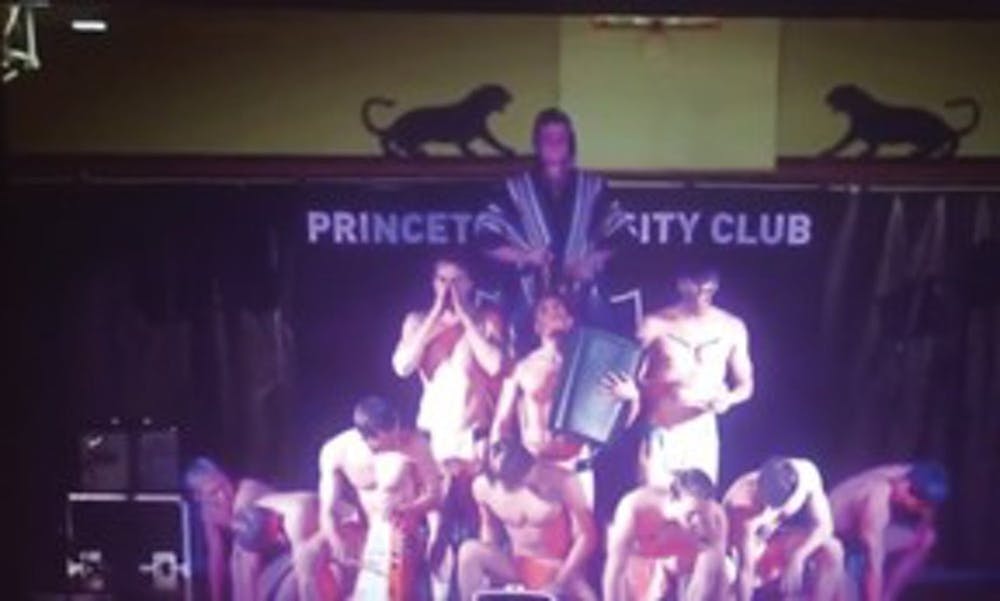
Screenshot from a video of a performance by Urban Congo.
From The Daily Princetonian
After outrage erupted on social media, Urban Congo voluntarily disbanded, and its president apologized. The group did not face disciplinary consequences. But their actions had appalled BJL members, whose offense was only intensified when Eisgruber weighed in on the event in an email to the campus community.
Acknowledging that Urban Congo was “described by its own president as ‘inexcusably offensive,’” Eisgruber wrote, “Comedy, satire, and stage performances inevitably transgress boundaries. The controversies they provoke may be genuinely painful, but they are also fundamental to the life of any great University.”
Crockett sent Eisgruber an email in response.
“It is not ‘fundamental’ to any academic setting to have ‘debates’ that make its students of color feel threatened at a time when white on Black (unpunished) violence is so prevalent that a Black student may have a legitimate fear of what a white student who defends racism in a ‘debate’ may well do when Public Safety is not around,” she wrote.
Crockett also noted that nowhere did Eisgruber mention racism, Black students, or Black people. Instead, he wrote that “some members of the community” had been hurt by Urban Congo’s actions.
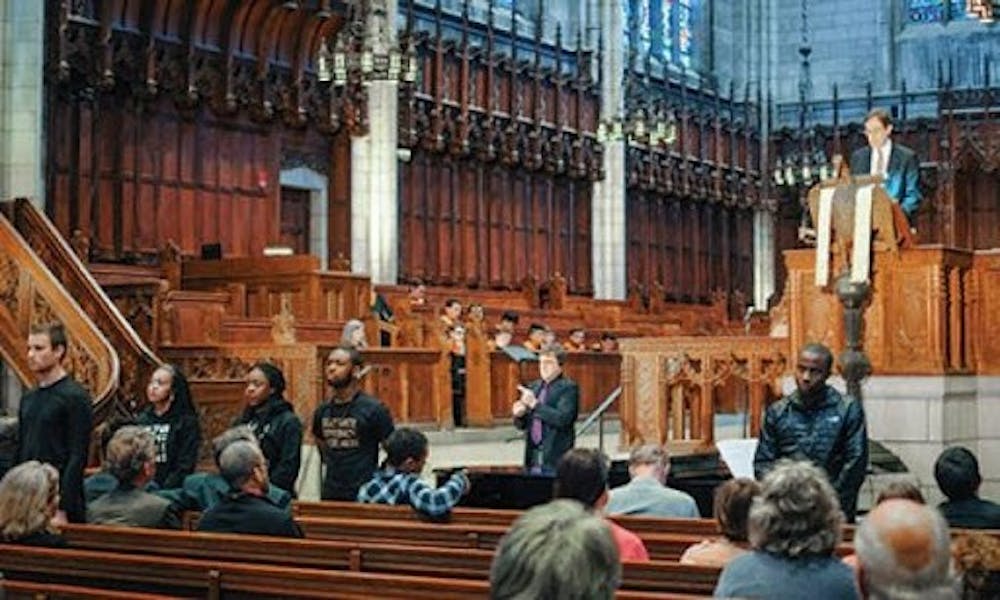
Students protested a gathering at the Chapel on April 12, 2015.
Yicheng Sun ’16 / The Daily Princetonian, Princeton Alumni Weekly
On April 12, 2015, the University held a gathering at the Chapel, which drew about 200 people, to discuss the campus climate and tension between free speech and a “welcoming community,” according to Princeton Alumni Weekly (PAW). Eisgruber, Professor of African American Studies Ruha Benjamin, Professor of English William Gleason, and others spoke at the event.
When Eisgruber rose to the podium, BJL members in the audience stood and turned their backs. Clad in all-black, they walked down the aisle carrying posters, including ones that read, “‘[Racism] is fundamental to the life of any great University’ — Christopher Eisgruber.”
On campus, backlash to the protest was intense. The ‘Prince’ Editorial Board denounced the BJL protesters for their “flagrant misquoting” of Eisgruber’s words, writing, “The protesters read the quote in this way out of a misguided belief that Eisgruber meant this to say that performances such as the one by Urban Congo are essential to the well-being of the University.”
The Board then urged students to ponder the “blurry line between acceptable artistic expression and offensive speech,” closing with an endorsement of Eisgruber’s email.
“We commend Eisgruber for his thoughtful response reminding us of that need,” they wrote.
On YikYak, the then-ubiquitous anonymous social media platform, condemnations of the protest quickly turned to personal insults, as Buzzfeed documented at the time. Students anonymously defended Urban Congo and made racist statements while doing so.
“African tribes have contributed close to nothing to modern society,” one YikYak user wrote.
Although YikYak’s terms of service prohibited calling out individuals by name, Anyanwu said that she and other BJL members were referenced by initial and class year. In her case, users wrote: “I’m sorry but JA ’15 is just as racist as any,” “Please raise your hand if you have ever been personally victimized by JA’15,” “Does anyone else feel unsafe with JA ’15 on campus?”
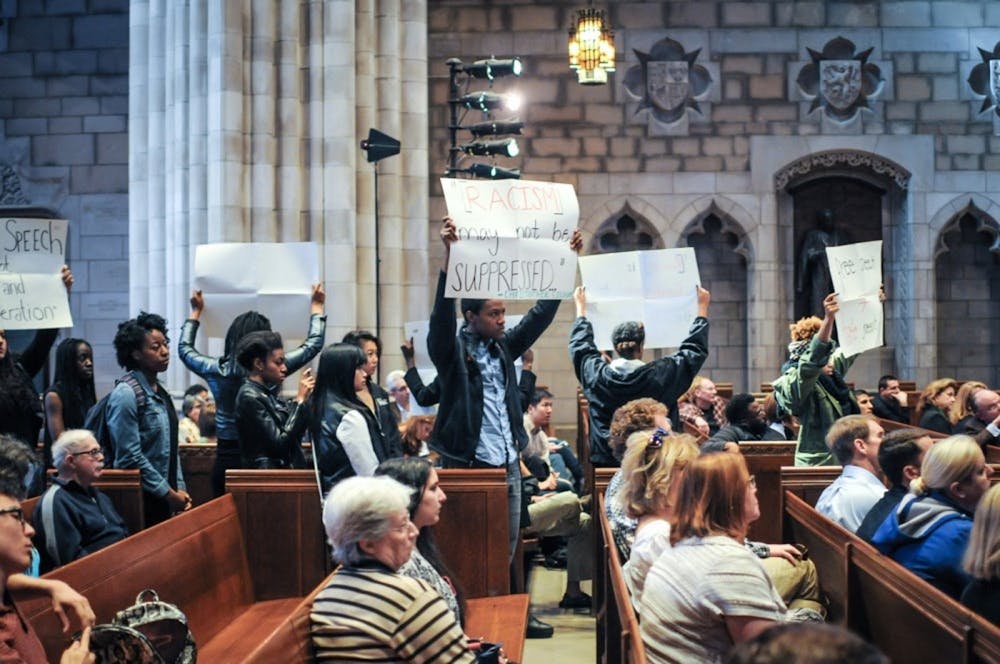
At the chapel gathering, students held up signs accusing President Eisgruber of allowing racism to persist on campus.
Yicheng Sun ’16 / The Daily Princetonian, Princeton Alumni Weekly
A message for all student protesters garnered 72 upvotes: “If Princeton is so ‘damaging’, ~leave~... Good luck finding somewhere that can accommodate your hypersensitivity + neuroses.”
“A lot of us did not feel safe at Princeton,” said Trust Kupupika ’17, a former BJL member. “It was not how an undergraduate experience should be, but that’s what it was for us, because we decided to stand up for what we believed in.”
Despite such harassment, Kupupika described her time in the BJL as one of support and love from peers and faculty, especially those in the Department of African American Studies. Through the BJL, she made “lifelong friends.”
“We were just kids at the time,” Kupupika said. “We were just trying to do what we had to do and came up against a big thing called ‘racism.’ We see a problem and solve it.”
According to Anyanwu, the BJL saw themselves as following in the footsteps of Black civil rights leader Ella Jo Baker. Baker orchestrated lunch counter sit-ins at North Carolina A&T University in 1960, helped found the Student Nonviolent Coordinating Committee, and advocated for audacious and democratic methods of direct action.
Inspired by Baker’s focus on building a collective movement, rather than one centered around a single charismatic leader, the BJL organized itself horizontally, Anyanwu explained. BJL members tried to ensure that each of their voices would matter as much as any other, and all decisions were made by unanimous vote.
“You didn’t see me on television, you didn’t see news stories about me,” Baker once said. “The kind of role that I tried to play was to pick up pieces or put together pieces out of which I hoped organization might come. My theory is, strong people don’t need strong leaders.”
Despite their emphasis on unity, Anyanwu noted that members did not always see eye to eye. She credited Ozi Obi-Onuoha ’16 for bringing them together and healing internal fissures. Obi-Onuoha passed away on May 8, 2019.
“Ozi was ahead of our time, ahead in terms of politics,” Anyanwu said. “I would like their name to be mentioned in the article. I wish they could have lived to see the victories that we’ve achieved.”
Anyanwu said that while she could bear criticism and hatred from non-Black students and faculty, dissent from Black students who did not agree with the BJL’s methods or demands hurt much more.
“Friendships were falling apart,” said Kupupika. “A lot of Black students would say stuff like, ‘How dare you speak for me?’ ‘How dare you call yourselves the Black Justice League?’”
Crockett echoed this sentiment.
“I think the most painful backlash and the most frustrating backlash has not been from white students and not been from administrators; it has always been from Black students,” she told the ‘Prince’ in 2017.
To heal divides within the University’s Black community, Anyanwu and Kupupika recalled that the BJL held public forums inviting all Black students to express their concerns.
In the end, unanimity proved impossible. But the BJL would continue to fight for racial justice in the ways its members saw fit.





